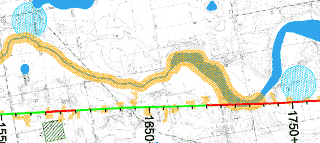Liquids release modeling for high consequence area impact determination. Direct and indirect analyses, comprehensive release volume calculation and state-of-the-art overland/hydrological transport modeling.
RiskFrame® Liquids HCA Analysis provides determination of impacts using state-of-the-art overland and hydrological release modeling, identifying and locating pipeline segments that could impact high consequence areas (HCAs). Proximity buffering reveals those HCAs that are directly or indirectly impacted by an analysis. Multiple levels of impact types are considered, which combine to provide a thorough, conservative and justifiable approach to impact modeling. Detailed documentation and results data describe the finest level of detail behind the analysis, explaining any result, both as stationed impact segments and on detailed integrity sheets. Resulting segments are identified by type of HCA, impact type and transport characteristics.
 Direct and Indirect Analysis
Direct and Indirect Analysis
Proximity buffering is used to determine those HCAs that a pipeline directly impacts and is within a specified distance of. This establishes those HCAs that the pipeline would affect through an immediate and localized impact.
 Drain & Release Volume Calculation
Drain & Release Volume Calculation
Because the area that a spill would occupy, and therefore the path it would take, is related to the volume of available product, it is necessary to model a potential release volume at each point. This analysis takes into account terrain effects (pooling in valleys, for example), as well as additional volumes that are released due to surge pressures, response times to close valves and other operational factors.
 Once the potential release volume is calculated, it is used in the next stage, Overland Spread™ plume modeling.
Once the potential release volume is calculated, it is used in the next stage, Overland Spread™ plume modeling.
 Advanced Hydrologic Transport Modeling
Advanced Hydrologic Transport Modeling
In the event a release impacts a part of the surface water system, hydrological modeling provides an analysis of the path it would take through the system. The path is determined by the complex interactions between stream segments, lakes and other surface water features.
 Surface water transport is analyzed with a velocity-based model that carries liquid downstream for the time it would take to install mitigation measures to contain the release. The modeling of stream velocity is perhaps the most in-depth part of the hydraulic transport model as most stream segments are not monitored for flow velocity, so a complex model involving flow accumulation, discharge statistics and gradient was developed and continues to be refined.
Surface water transport is analyzed with a velocity-based model that carries liquid downstream for the time it would take to install mitigation measures to contain the release. The modeling of stream velocity is perhaps the most in-depth part of the hydraulic transport model as most stream segments are not monitored for flow velocity, so a complex model involving flow accumulation, discharge statistics and gradient was developed and continues to be refined.
 Detailed Reporting
Detailed Reporting
Map products from the RiskFrame Liquids HCA Analysis are configured to meet several different specifications. The HCA impact bands on delivered integrity alignment sheets directly relate to the map and show the segments that the analysis determines have the potential to impact an HCA are indicated as red bars, organized by HCA type.
 In addition, a series of tabular and spatial data outputs are generated to allow the results to be integrated into the client’s pipeline database. Clients that already use GeoFields pipeline data management system receive scripts to update their database.
In addition, a series of tabular and spatial data outputs are generated to allow the results to be integrated into the client’s pipeline database. Clients that already use GeoFields pipeline data management system receive scripts to update their database.
 Release Point Calculation
Release Point Calculation
Points along the pipeline are designated for modeling purposes as potential release points. These are typically evenly spaced at a high density, and are supplemented with significant terrain features such as particularly sensitive locations e.g. water crossings. The resulting set of release points forms the basis for each of the subsequent analyses. In the final stage of the analysis, those points that have the potential to impact a high consequence area are used to generate HCA could-affect segments.
The resulting set of release points forms the basis for each of the subsequent analyses. In the final stage of the analysis, those points that have the potential to impact a high consequence area are used to generate HCA could-affect segments.
 Wave-Front Overland Spread™
Wave-Front Overland Spread™
The path that a pipeline release would take is not a simple point-to-point analysis. Released product has interactions with terrain including reflected wave fronts, pooling in low points, spreading in multiple directions and leaving a residual volume. A sophisticated spill analysis considers these factors; the Overland Spread™ component of RiskFrame Liquids HCA Analysis accounts for all of these. In addition, through the use of a variable product retention parameter, the evaporation and absorption characteristics of the product are accounted for.
 Quality Control
Quality Control
GeoFields incorporates several Quality Assurance and Quality Control (QA/QC) checks to assure accurate results of the Liquids HCA Analysis. The underlying data, having such a vast extent and detail, may contain errors. Any errors are either trapped by the model itself or by subsequent quality control procedures. This flagging procedure identifies plumes, which, for a number of possible reasons, have not met criteria established by the client or GeoFields.

